Effect and Mechanism of Pitch Coating on the Rate Performance Improvement of Lithium-Ion Batteries
Abstract
:1. Introduction
2. Experimental
2.1. Sample Preparation
2.2. Characterization
2.3. Electrochemical Measurements
3. Results and Discussion
3.1. Properties
3.2. Electrochemical Performance
3.3. Reason for the Improved Electrochemical Performance of Pitch-Coated Graphite
3.4. Schematic of Electrode Structure after Pressing Process
4. Conclusions
- (1)
- Graphite (FG) exhibited particle orientation during the rolling process, and since the particles were oriented perpendicular to the lithium-ion diffusion direction, the pathway of lithium ions was extended, and intercalation/deintercalation was limited, resulting in a deteriorated rate of performance of 9.07% (5 C-rate/0.2 C-rate);
- (2)
- In the case of uniform pitch-coated graphite (CFG5), the amorphous carbon with a randomly oriented structure and small crystal size provided a lithium diffusion pathway on the surface. In addition, the pitch made the particles more spherical and helped relieve the particle orientation. The result was a superior rate performance of 80.58% (5 C-rate/0.2 C-rate), an improvement of more than eight times compared to that of FG;
- (3)
- Excessive pitch addition resulted in pitch aggregation rather than a thicker coating. Such an aggregation caused a nonuniform particle surface and shape, which increased the interfacial resistance and charge transfer resistance and decreased the rate of performance. Nevertheless, the rate performance was improved compared to that of graphite, which was attributed to the amorphous structure of the pitch and relaxation of particle orientation by some of the coated pitches.
Supplementary Materials
Author Contributions
Funding
Institutional Review Board Statement
Informed Consent Statement
Data Availability Statement
Conflicts of Interest
References
- Nagaura, T. Development of Rechargeable Lithium Batteries. II. Lithium Ion Rechargeable Batteries. Prog. Batter. Battery Mater. 1991, 10, 218–226. [Google Scholar]
- Ohzuku, T.; Iwakoshi, Y.; Sawai, K. Formation of lithium-graphite intercalation compounds in nonaqueous electrolytes and their application as a negative electrode for a lithium ion (shuttlecock) cell. J. Electrochem. Soc. 1993, 140, 2490. [Google Scholar] [CrossRef]
- Yoshio, M.; Wang, H.; Fukuda, K.; Umeno, T.; Abe, T.; Ogumi, Z. Improvement of natural graphite as a lithium-ion battery anode material, from raw flake to carbon-coated sphere. J. Mater. Chem. 2004, 14, 1754–1758. [Google Scholar] [CrossRef]
- Guoping, W.; Bolan, Z.; Min, Y.; Xiaoluo, X.; Meizheng, Q.; Zuolong, Y. A modified graphite anode with high initial efficiency and excellent cycle life expectation. Solid State Ion. 2005, 176, 905–909. [Google Scholar] [CrossRef]
- Lee, Y.-T.; Yoon, C.S.; Prakash, J.; Sun, Y.-K. Effect of Li-doping on electrochemical performance of natural graphite anode for lithium secondary batteries. J. Electrochem. Soc. 2004, 151, A1728. [Google Scholar] [CrossRef]
- Glenis, S.; Nelson, A.; Labes, M. Sulfur doped graphite prepared via arc discharge of carbon rods in the presence of thiophenes. J. Appl. Phys. 1999, 86, 4464–4466. [Google Scholar] [CrossRef]
- Yoshio, M.; Wang, H.; Fukuda, K. Spherical carbon-coated natural graphite as a lithium-ion battery-anode material. Angew. Chem. Int. Ed. 2003, 42, 4203–4206. [Google Scholar] [CrossRef]
- Nič, M.; Jirát, J.; Košata, B.; Jenkins, A.; McNaught, A. IUPAC Gold Book: Compendium of Chemical Terminology; International Union of Pure and Applied Chemistry: Research Triangle Park, NC, USA, 2014; p. 1134. [Google Scholar]
- Han, Y.J.; Hwang, J.U.; Kim, K.S.; Kim, J.H.; Lee, J.D.; Im, J.S. Optimization of the preparation conditions for pitch based anode to enhance the electrochemical properties of LIBs. J. Ind. Eng. Chem. 2019, 73, 241–247. [Google Scholar] [CrossRef]
- Choi, S.H.; Nam, G.; Chae, S.; Kim, D.; Kim, N.; Kim, W.S.; Ma, J.; Sung, J.; Han, S.M.; Ko, M. Robust pitch on silicon nanolayer–embedded graphite for suppressing undesirable volume expansion. Adv. Energy Mater. 2019, 9, 1803121. [Google Scholar] [CrossRef]
- Zhu, Y.-Y.; Guo, Y.; Wang, C.-Y.; Qiao, Z.-J.; Chen, M.-M. Fabrication of conductive carbonaceous spherical architecture from pitch by spray drying. Chem. Eng. Sci. 2015, 135, 109–116. [Google Scholar] [CrossRef]
- Im, U.-S.; Hwang, J.U.; Yun, J.H.; Ahn, W.; Kim, K.S.; Im, J.S. The effect of mild activation on the electrochemical performance of pitch-coated graphite for the lithium-ion battery anode material. Mater. Lett. 2020, 278, 128421. [Google Scholar] [CrossRef]
- Jo, Y.J.; Lee, J.D. Electrochemical characteristics of artificial graphite anode coated with petroleum pitch treated by solvent. Korean Chem. Eng. Res. 2019, 57, 5–10. [Google Scholar]
- Jo, J.H.; Choi, J.U.; Kim, H.J.; Yashiro, H.; Myung, S.-T. Synthesis and electrochemical reaction of a pitch carbon-coated zinc vanadium oxide anode with excellent electrochemical performance for rechargeable lithium batteries. ACS Sustain. Chem. Eng. 2020, 8, 1908–1915. [Google Scholar] [CrossRef]
- Choi, J.H.; Park, G.D.; Jung, D.S.; Kang, Y.C. Pitch-derived carbon coated SnO2–CoO yolk–shell microspheres with excellent long-term cycling and rate performances as anode materials for lithium-ion batteries. Chem. Eng. J. 2019, 369, 726–735. [Google Scholar] [CrossRef]
- Dunlap, N.A.; Kim, S.; Jeong, J.J.; Oh, K.H.; Lee, S.-H. Simple and inexpensive coal-tar-pitch derived Si-C anode composite for all-solid-state Li-ion batteries. Solid State Ion. 2018, 324, 207–217. [Google Scholar] [CrossRef]
- Han, Y.-J.; Kim, J.; Yeo, J.-S.; An, J.C.; Hong, I.-P.; Nakabayashi, K.; Miyawaki, J.; Jung, J.-D.; Yoon, S.-H. Coating of graphite anode with coal tar pitch as an effective precursor for enhancing the rate performance in Li-ion batteries: Effects of composition and softening points of coal tar pitch. Carbon 2015, 94, 432–438. [Google Scholar] [CrossRef]
- Yoon, S.; Kim, H.; Oh, S.M. Surface modification of graphite by coke coating for reduction of initial irreversible capacity in lithium secondary batteries. J. Power Sources 2001, 94, 68–73. [Google Scholar] [CrossRef]
- Abu-Lebdeh, T.M.; Damptey, R.; Ungureanu, L.M.; Petrescu, F.I.T. A Ternary Model for Particle Packing Optimization. J. Compos. Sci. 2022, 6, 113. [Google Scholar] [CrossRef]
- Lee, S.; Go, N.; Ryu, J.H.; Mun, J. Multidimensional Conducting Agents for a High-Energy-Density Anode with SiO for Lithium-Ion Batteries. J. Electrochem. Sci. Technol. 2019, 10, 244–249. [Google Scholar]
- Shroder, R.; Nemanich, R.; Glass, J. Analysis of the composite structures in diamond thin films by Raman spectroscopy. Phys. Rev. B 1990, 41, 3738. [Google Scholar] [CrossRef]
- Tai, F.; Wei, C.; Chang, S.; Chen, W. Raman and X-ray diffraction analysis on unburned carbon powder refined from fly ash. J. Raman Spectrosc. 2010, 41, 933–937. [Google Scholar] [CrossRef]
- Kim, S.-G.; Park, O.-K.; Lee, J.H.; Ku, B.-C. Layer-by-layer assembled graphene oxide films and barrier properties of thermally reduced graphene oxide membranes. Carbon Lett. 2013, 14, 247–250. [Google Scholar] [CrossRef] [Green Version]
- Zheng, T.; McKinnon, W.; Dahn, J. Hysteresis during lithium insertion in hydrogen-containing carbons. J. Electrochem. Soc. 1996, 143, 2137. [Google Scholar] [CrossRef]
- Novák, P.; Joho, F.; Imhof, R.; Panitz, J.-C.; Haas, O. In situ investigation of the interaction between graphite and electrolyte solutions. J. Power Sources 1999, 81, 212–216. [Google Scholar] [CrossRef]
- Zhang, S.; Ding, M.S.; Xu, K.; Allen, J.; Jow, T.R. Understanding solid electrolyte interface film formation on graphite electrodes. Electrochem. Solid-State Lett. 2001, 4, A206. [Google Scholar] [CrossRef]
- Kim, T.; Choi, W.; Shin, H.-C.; Choi, J.-Y.; Kim, J.M.; Park, M.-S.; Yoon, W.-S. Applications of voltammetry in lithium ion battery research. J. Electrochem. Sci. Technol. 2020, 11, 14–25. [Google Scholar] [CrossRef] [Green Version]
- Dimov, N.; Kugino, S.; Yoshio, M. Carbon-coated silicon as anode material for lithium ion batteries: Advantages and limitations. Electrochim. Acta 2003, 48, 1579–1587. [Google Scholar] [CrossRef]
- Yoshio, M.; Wang, H.; Fukuda, K.; Umeno, T.; Dimov, N.; Ogumi, Z. Carbon-coated Si as a lithium-ion battery anode material. J. Electrochem. Soc. 2002, 149, A1598. [Google Scholar] [CrossRef]
- Li, Y.; Tu, J.; Huang, X.; Wu, H.; Yuan, Y. Nanoscale SnS with and without carbon-coatings as an anode material for lithium ion batteries. Electrochim. Acta 2006, 52, 1383–1389. [Google Scholar] [CrossRef]
- Fang, M.-D.; Ho, T.-H.; Yen, J.-P.; Lin, Y.-R.; Hong, J.-L.; Wu, S.-H.; Jow, J.-J. Preparation of advanced carbon anode materials from mesocarbon microbeads for use in high C-rate lithium ion batteries. Materials 2015, 8, 3550–3561. [Google Scholar] [CrossRef] [Green Version]
- Guo, Z.; Wang, C.; Chen, M.; Li, M. Hard carbon derived from coal tar pitch for use as the anode material in lithium ion batteries. Int. J. Electrochem. Sci. 2013, 8, 2702–2709. [Google Scholar]
- Lee, S.E.; Kim, J.H.; Lee, Y.-S.; Im, J.S. Effect of coke orientation on the electrochemical properties of lithium-ion battery anode. J. Appl. Electrochem. 2021, 51, 1407–1418. [Google Scholar] [CrossRef]
- Ogihara, N.; Kawauchi, S.; Okuda, C.; Itou, Y.; Takeuchi, Y.; Ukyo, Y. Theoretical and experimental analysis of porous electrodes for lithium-ion batteries by electrochemical impedance spectroscopy using a symmetric cell. J. Electrochem. Soc. 2012, 159, A1034. [Google Scholar] [CrossRef]
- Zhang, S.; Xu, K.; Jow, T. Electrochemical impedance study on the low temperature of Li-ion batteries. Electrochim. Acta 2004, 49, 1057–1061. [Google Scholar] [CrossRef]
- Bard, A.; Faulkner, L.; Leddy, J.; Zoski, C.G. Electrochemical Methods: Fundamentals and Applications; John Wiley & Sons: Hoboken, NJ, USA, 1980; p. 222. [Google Scholar]
- Mochida, I.; Yoon, S.-H.; Korai, Y. Preparation and structure of mesophase pitch-based thin carbon tape. J. Mater. Sci. 1993, 28, 2135–2140. [Google Scholar] [CrossRef]
- Asenbauer, J.; Eisenmann, T.; Kuenzel, M.; Kazzazi, A.; Chen, Z.; Bresser, D. The success story of graphite as a lithium-ion anode material–fundamentals, remaining challenges, and recent developments including silicon (oxide) composites. Sustain. Energy Fuels 2020, 4, 5387–5416. [Google Scholar] [CrossRef]
- Akbari, A.; Cunning, B.V.; Joshi, S.R.; Wang, C.; Camacho-Mojica, D.C.; Chatterjee, S.; Modepalli, V.; Cahoon, C.; Bielawski, C.W.; Bakharev, P. Highly ordered and dense thermally conductive graphitic films from a graphene oxide/reduced graphene Oxide mixture. Matter 2020, 2, 1198–1206. [Google Scholar] [CrossRef]
- Pfaffmann, L.; Birkenmaier, C.; Müller, M.; Bauer, W.; Mitsch, T.; Feinauer, J.; Krämer, Y.; Scheiba, F.; Hintennach, A.; Schleid, T. Investigation of the electrochemically active surface area and lithium diffusion in graphite anodes by a novel OsO4 staining method. J. Power Sources 2016, 307, 762–771. [Google Scholar] [CrossRef]
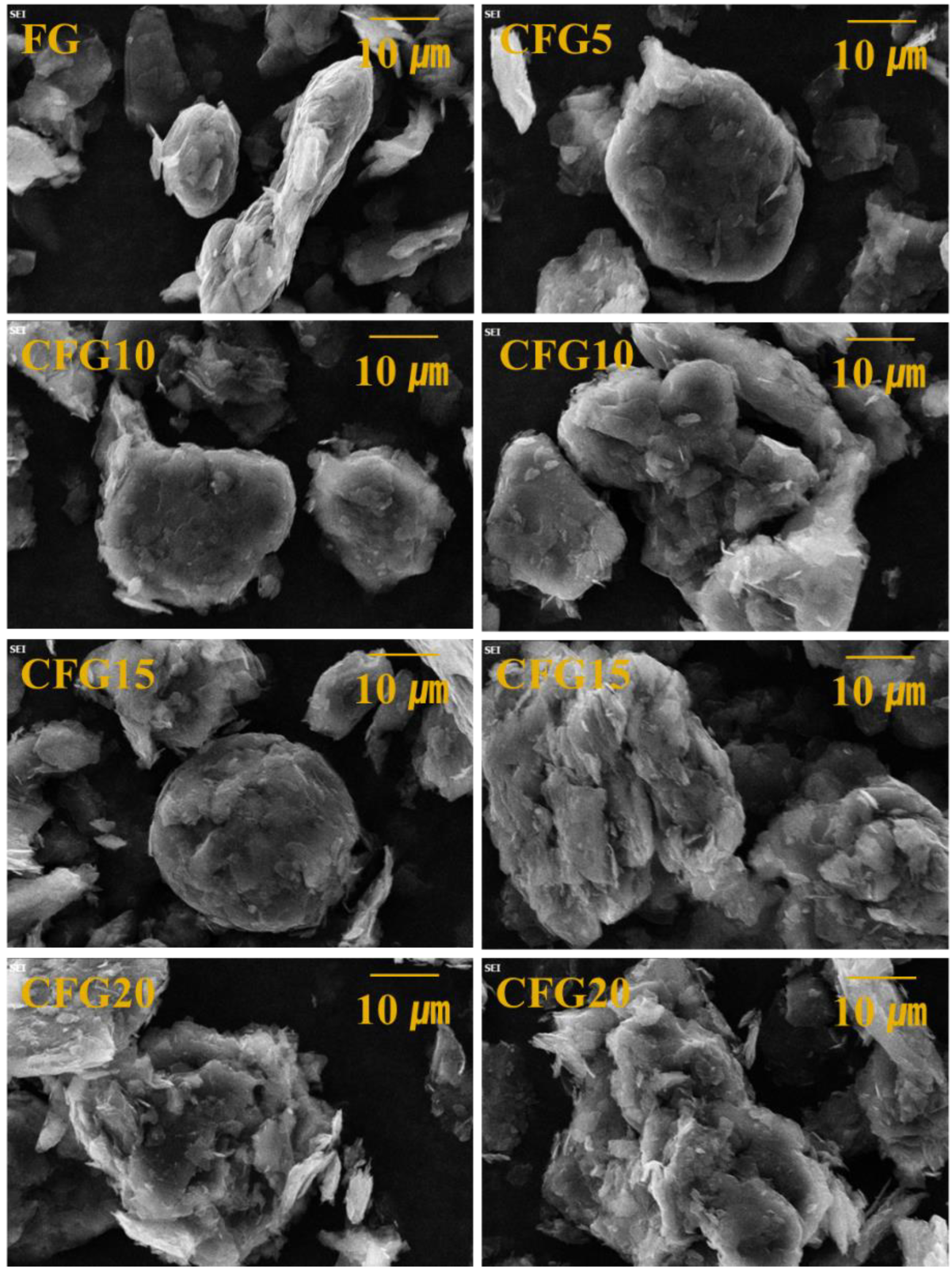
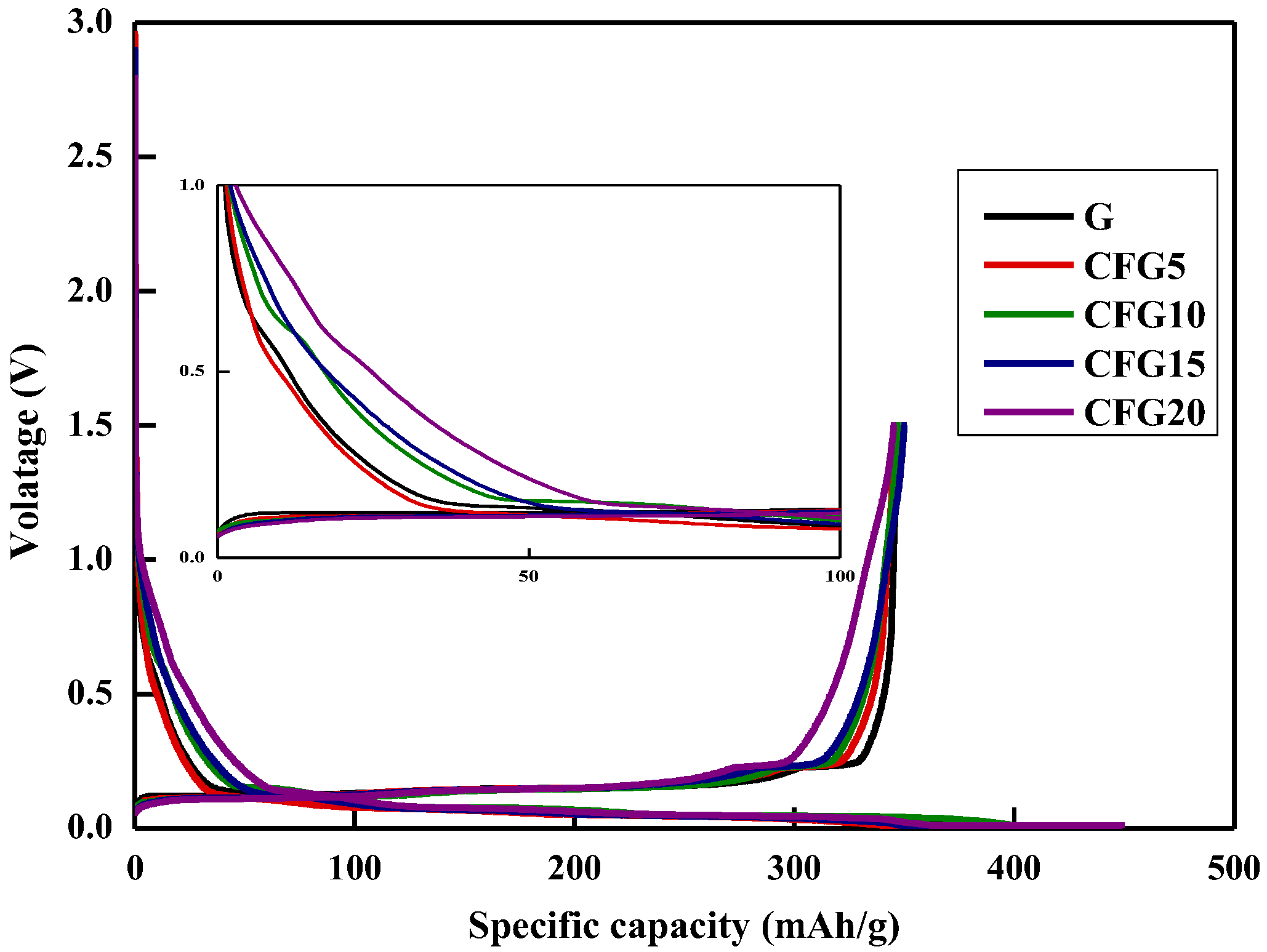
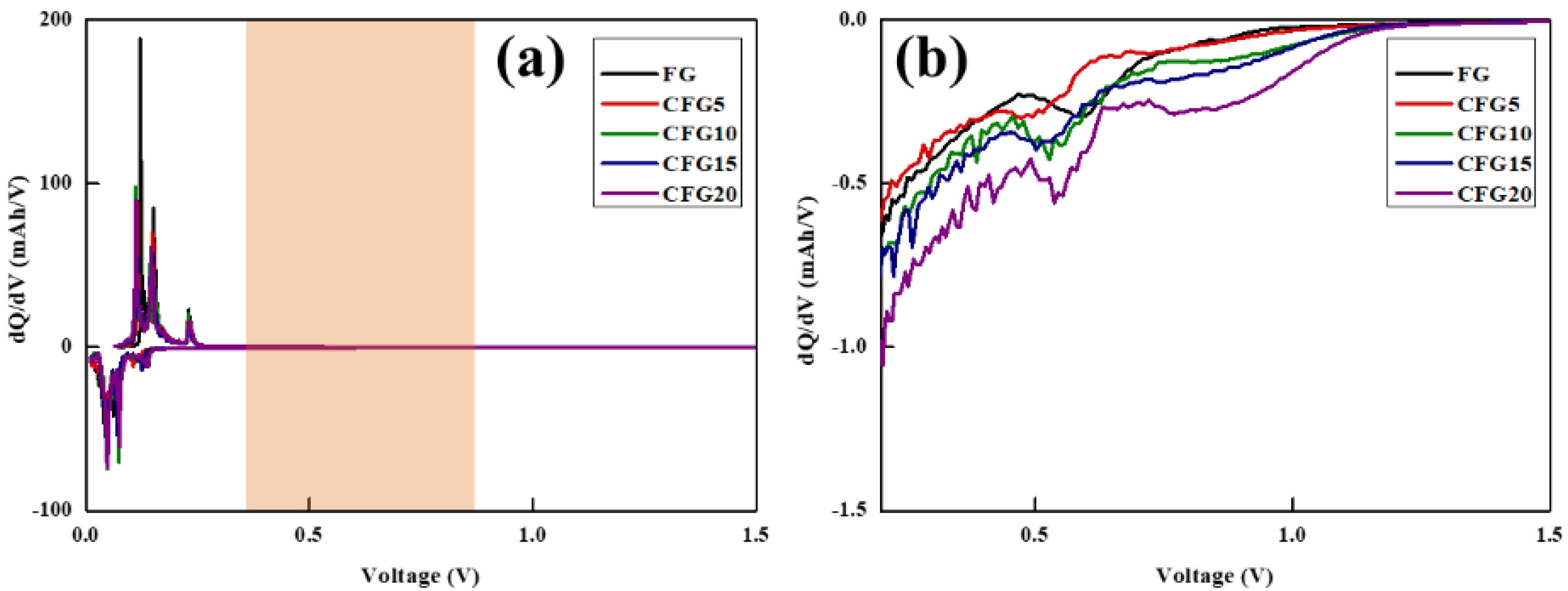
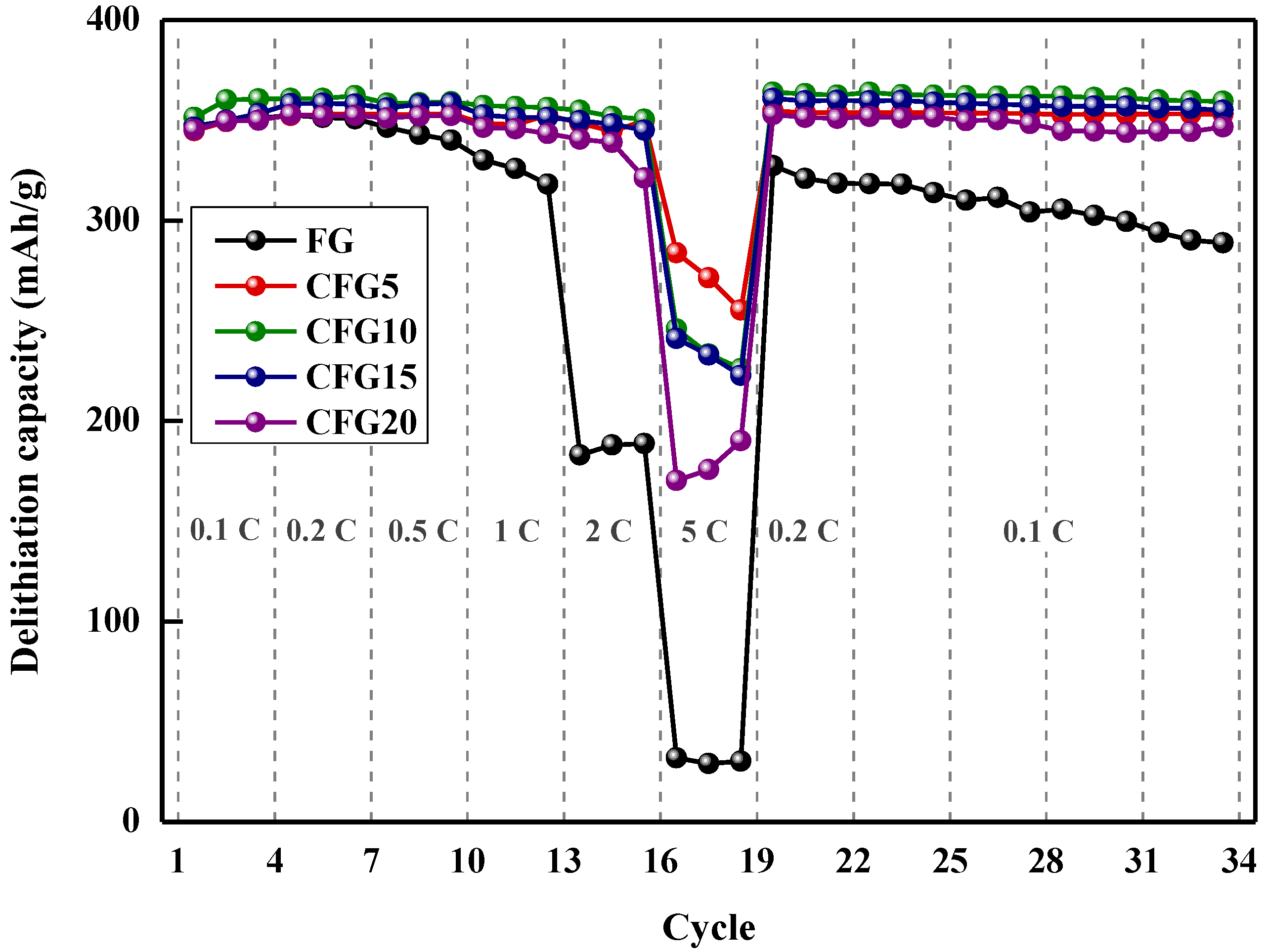
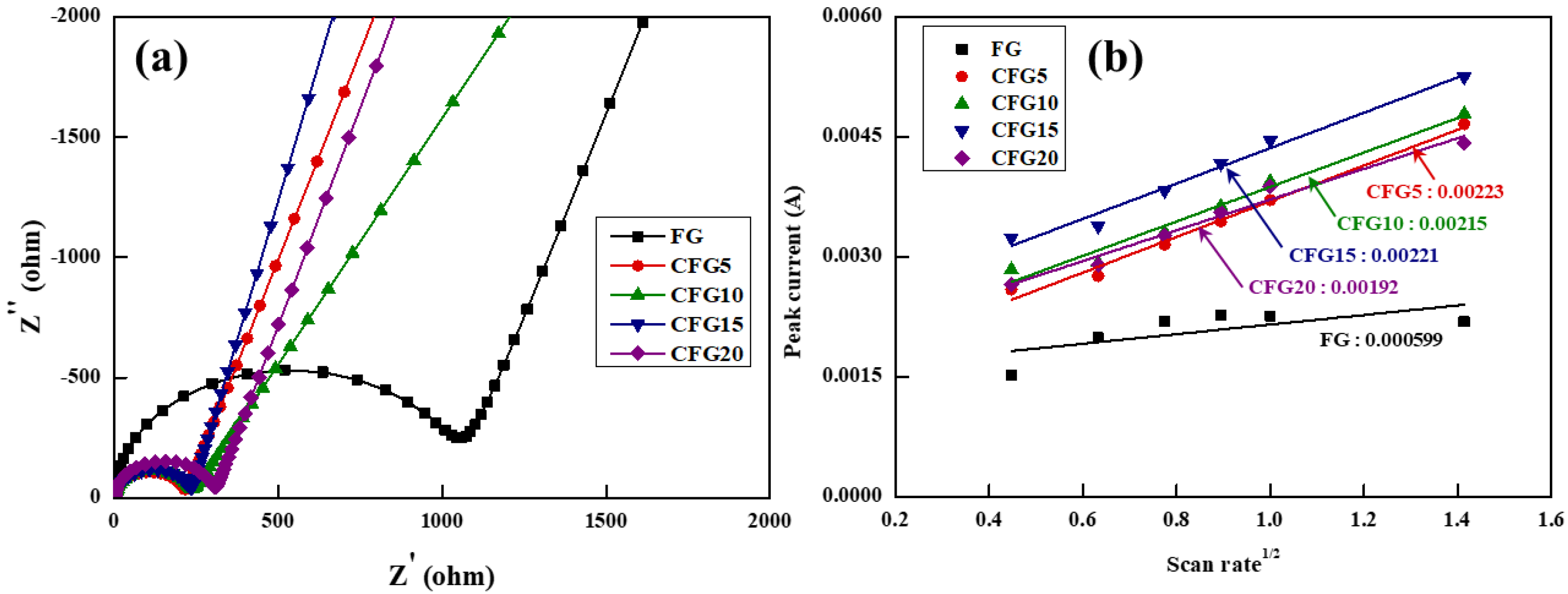
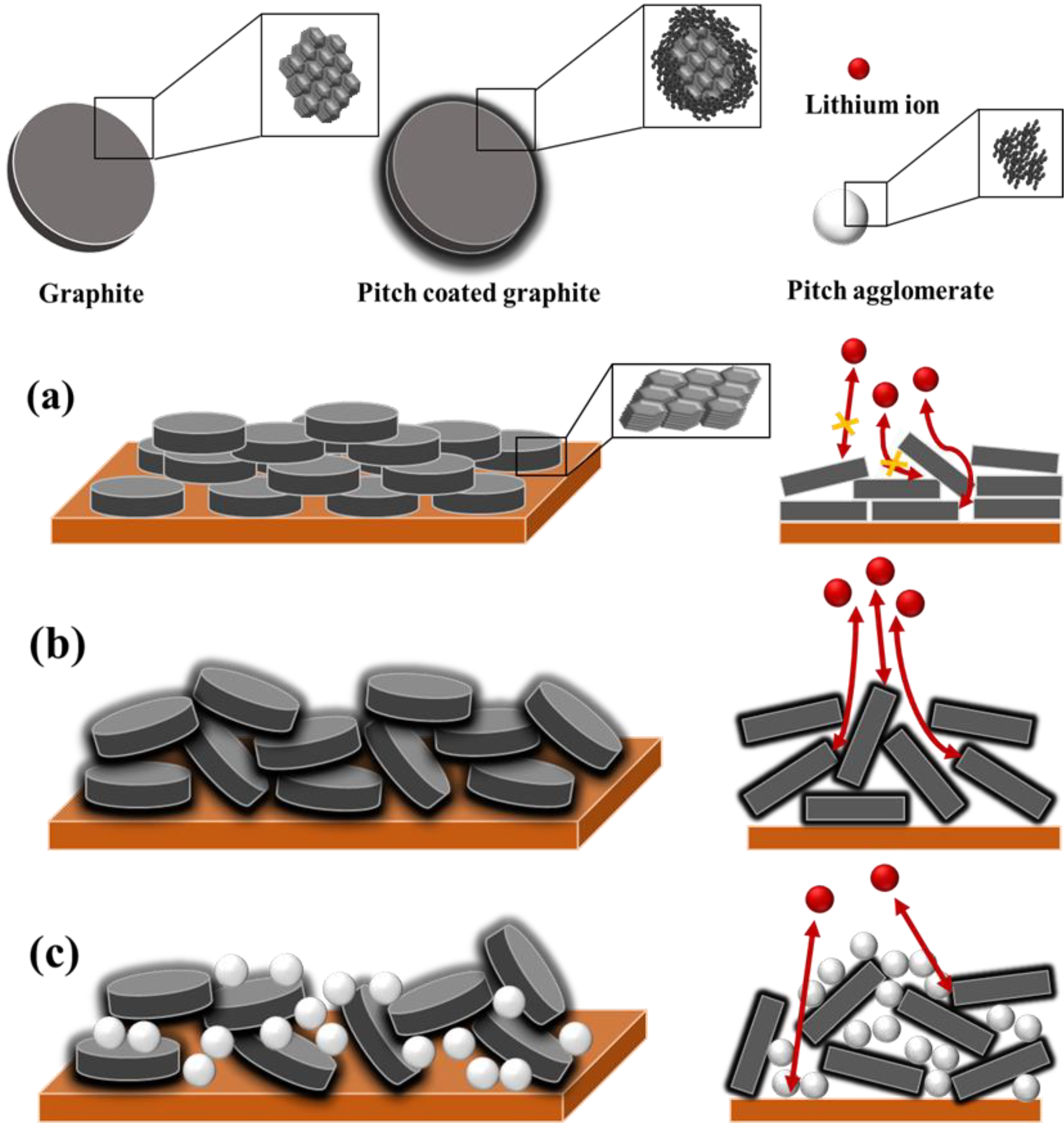
| D10 | D50 | D90 | FWHM | BET Surface Area | |
|---|---|---|---|---|---|
| FG | 6.83 | 14.9 | 27.43 | 15.45 | 32.31 |
| CFG5 | 8.06 | 16.65 | 28.85 | 15.49 | 6.36 |
| CFG10 | 7.97 | 17.19 | 29.98 | 16.54 | 9.81 |
| CFG15 | 7.85 | 18.16 | 33.16 | 18.49 | 5.66 |
| CFG20 | 5.27 | 16.76 | 34.01 | 21.72 | 7.06 |
| AD/AG | Average | STDEV | |
|---|---|---|---|
| FG | 0.585 | 0.555 | 0.0452 |
| 0.589 | |||
| 0.491 | |||
| CFG5 | 1.837 | 1.8361 | 0.0138 |
| 1.852 | |||
| 1.819 | |||
| CFG10 | 1.523 | 1.709 | 0.1324 |
| 1.821 | |||
| 1.783 | |||
| CFG15 | 1.888 | 1.913 | 0.1567 |
| 2.117 | |||
| 1.736 | |||
| CFG20 | 1.754 | 1.825 | 0.2838 |
| 2.203 | |||
| 1.519 |
| FG | CFG5 | CFG10 | CFG15 | CFG20 | Pitch (900 °C) | |
| Packing Density (g/cm3) | 1.55 | |||||
| Conductivity (S/cm) | 188.89 | 183.16 | 166.39 | 161.47 | 151.73 | 34.67 |
Publisher’s Note: MDPI stays neutral with regard to jurisdictional claims in published maps and institutional affiliations. |
© 2022 by the authors. Licensee MDPI, Basel, Switzerland. This article is an open access article distributed under the terms and conditions of the Creative Commons Attribution (CC BY) license (https://creativecommons.org/licenses/by/4.0/).
Share and Cite
Kim, B.-R.; Kim, J.-H.; Im, J.-S. Effect and Mechanism of Pitch Coating on the Rate Performance Improvement of Lithium-Ion Batteries. Materials 2022, 15, 4713. https://doi.org/10.3390/ma15134713
Kim B-R, Kim J-H, Im J-S. Effect and Mechanism of Pitch Coating on the Rate Performance Improvement of Lithium-Ion Batteries. Materials. 2022; 15(13):4713. https://doi.org/10.3390/ma15134713
Chicago/Turabian StyleKim, Bo-Ra, Ji-Hong Kim, and Ji-Sun Im. 2022. "Effect and Mechanism of Pitch Coating on the Rate Performance Improvement of Lithium-Ion Batteries" Materials 15, no. 13: 4713. https://doi.org/10.3390/ma15134713





